¿Quieres mostrar diferentes menús a los usuarios conectados en WordPress?
Por defecto, WordPress te permite mostrar el mismo menú de navegación en una ubicación específica de tu tema. Pero, ¿y si quisieras mostrar un menú diferente a los usuarios conectados en tu sitio web?
En este artículo, le mostraremos cómo mostrar fácilmente diferentes menús a los usuarios conectados en WordPress.
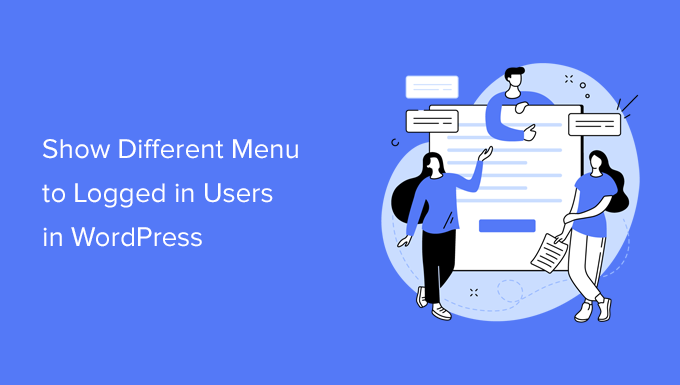
¿Por qué mostrar menús diferentes a los usuarios conectados en WordPress?
Cambiar las diferentes áreas de su sitio web WordPress en función de sus visitantes y su actividad hace que su sitio se sienta personalizado para cada usuario.
Este contenido personalizado le ayuda a mejorar la experiencia del usuario en su sitio web de WordPress.
Ahora bien, si gestiona un sitio web en el que los usuarios no necesitan registrarse ni acceder, probablemente pueda utilizar los mismos menús de navegación en todo su sitio web.
Sin embargo, otros sitios web pueden beneficiarse enormemente de mostrar menús personalizados a los usuarios conectados.
Por ejemplo, sitios web como una tienda en línea, una comunidad de sitios de membresía en WordPress o una plataforma de aprendizaje en línea pueden beneficiarse de menús de navegación personalizados.
Un menú de navegación personalizado para los usuarios conectados les ayuda a encontrar más fácilmente las cosas para las que se registraron.
Por ejemplo, un usuario de una tienda online puede gestionar su cuenta, o un miembro de una comunidad de pago puede renovar fácilmente su suscripción o ver los cursos online que ha comprado.
Por defecto, WordPress le permite crear tantos menús de navegación como desee. Sin embargo, solo puedes elegir mostrar un menú en una ubicación concreta de tu tema de WordPress.
Dicho esto, veamos cómo cambiar fácilmente este comportamiento y mostrar diferentes menús a los usuarios conectados en WordPress.
- Mostrar Diferentes Menús a Usuarios Conectados en WordPress Usando un Plugins
- Seleccionar Manualmente el Menú de Usuarios Conectados en WordPress Usando Código
Creación de menús para usuarios conectados y no conectados en WordPress
Independientemente del método que utilice, primero tendrá que crear los dos menús de navegación que desea mostrar a los usuarios conectados y desconectados.
Simplemente diríjase a la página Apariencia ” Menús en el escritorio de WordPress. Si ya tienes un menú de navegación que utilizas en tu sitio web para todos los usuarios, este puede ser tu menú por defecto.

Después, haga clic en el enlace “crear un nuevo menú” para crear un nuevo menú personalizado para sus usuarios conectados.
Aquí puede añadir elementos de menú que desee mostrar a los usuarios registrados o conectados. Por ejemplo, puede añadir al menú un enlace para cerrar la sesión.
En la parte izquierda de la pantalla puede ver un anuncio / catálogo / páginas de su sitio web. Simplemente marque / compruebe la casilla siguiente a cualquier página que desee añadir a su menú y haga clic en el botón “Añadir al menú”.
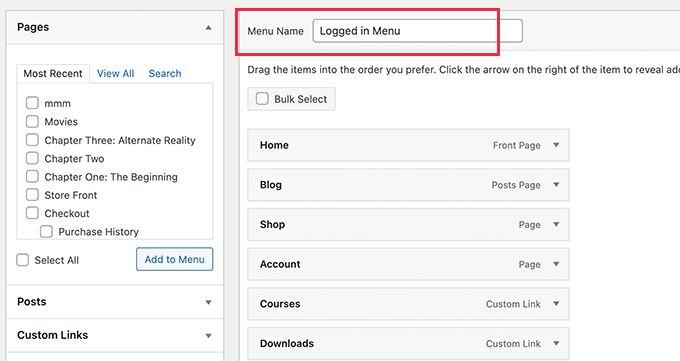
También puede arrastrar y soltar los elementos del menú en la parte derecha de la pantalla para reorganizarlos.
Más abajo en la página, puede elegir una ubicación para mostrar su menú. Pero, no necesita asignar una ubicación a este menú ahora. Lo haremos más adelante en este artículo.
No olvides hacer clic en el botón “Guardar menú” para guardar los cambios.
Para más detalles sobre la creación de menús, eche un vistazo a nuestra guía para principiantes sobre los menús de navegación de WordPress.
Método 1. Mostrar diferentes menús a los usuarios conectados en WordPress usando un plugin
Este método es más sencillo y recomendable para todos los usuarios de WordPress.
En primer lugar, debe instalar y activar el plugin Conditional Menus. Para más detalles, consulta nuestra guía paso a paso sobre cómo instalar un plugin de WordPress.
Una vez activado, debe visitar la página Apariencia ” Menús y cambiar a la pestaña “Gestionar ubicaciones”.
Desde aquí, verá la lista de ubicaciones de menú disponibles definidas en su tema de WordPress y los menús que se muestran actualmente.
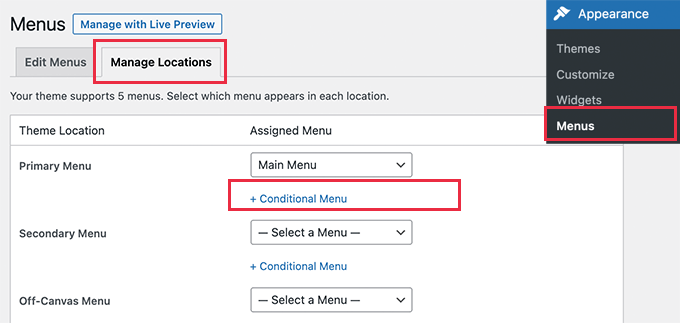
Por ejemplo, está mostrando que nuestra ubicación de Menú Principal está mostrando un menú de navegación titulado ‘Menú Principal’.
Ahora, necesitamos decirle al plugin que muestre un menú diferente cuando se cumpla cierta condición.
Para ello, haga clic en el enlace “+ Menú condicional” y, a continuación, seleccione en el menú desplegable el menú de navegación que desea mostrar a los usuarios conectados.

A continuación, deberá enlazar el enlace “+ Condiciones”.
Aparecerá una ventana emergente en la que podrás elegir entre varias condiciones.
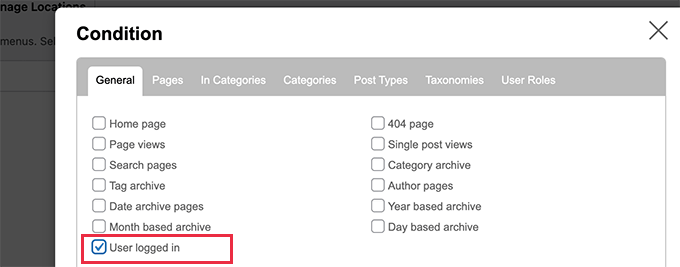
Sólo tiene que marcar la casilla situada junto a la opción “Usuario conectado” y, a continuación, hacer clic en el botón Guardar.
Ahora puede visitar su sitio web para ver en acción el menú del usuario conectado. También puede salir del administrador de WordPress para ver el menú de navegación que se mostrará a todos los demás usuarios.
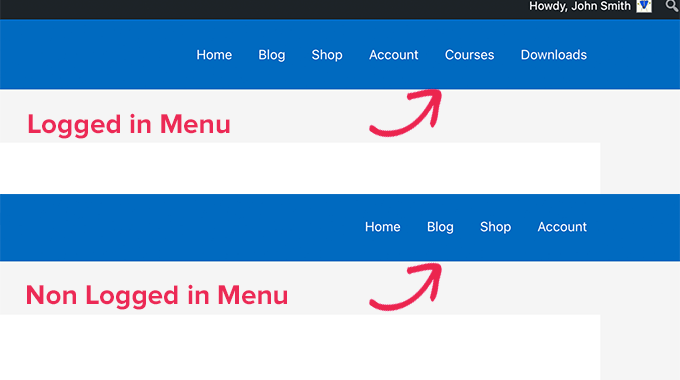
Método 2. Seleccionar manualmente el menú de conectados en WordPress usando código
Este método requiere que añadas código a tu sitio web WordPress. Si no lo has hecho antes, echa un vistazo a nuestra guía sobre cómo copiar y pegar fragmentos de código en WordPress.
En primer lugar, debe añadir el siguiente código al archivo functions. php de su tema o a un plugin específico del sitio.
function my_wp_nav_menu_args( $args = '' ) {
if( is_user_logged_in() ) {
// Logged in menu to display
$args['menu'] = 43;
} else {
// Non-logged-in menu to display
$args['menu'] = 35;
}
return $args;
}
add_filter( 'wp_nav_menu_args', 'my_wp_nav_menu_args' );
Asegúrese de sustituir 43 y 35 por los ID de los menús de navegación que creó anteriormente.
Puede encontrar el ID de un menú de navegación seleccionándolo en la página Menús. Verá el número de identificación del menú en la barra de direcciones de su navegador / explorador.
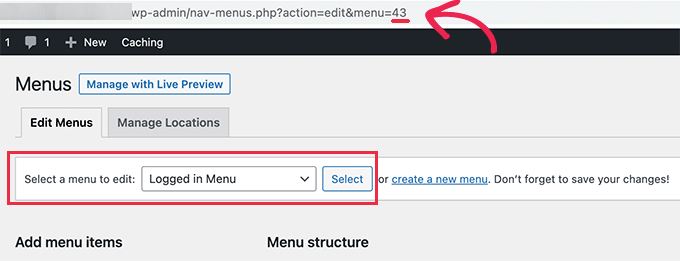
Esperamos que este artículo le haya ayudado a aprender cómo mostrar fácilmente diferentes menús de navegación a los usuarios conectados en WordPress.
También puedes consultar nuestra guía sobre cómo conseguir un dominio de correo electrónico gratuito o nuestro resumen de expertos sobre los mejores servicios telefónicos para pequeñas empresas.
If you liked this article, then please subscribe to our YouTube Channel for WordPress video tutorials. You can also find us on Twitter and Facebook.





Syed Balkhi says
Hey WPBeginner readers,
Did you know you can win exciting prizes by commenting on WPBeginner?
Every month, our top blog commenters will win HUGE rewards, including premium WordPress plugin licenses and cash prizes.
You can get more details about the contest from here.
Start sharing your thoughts below to stand a chance to win!
Jan-Paul Kleijn says
First I thought of a plugin. Gotta quit thinking like that.
Then I saw your post and was sold.
Thank you for posting this, you helped me very nicely.
Phil says
Thanks so much for that. Works perfectly.
Ariet says
Hello,
This totally works!
But it change my footer menu too.. is there a way where my footer manu stay the same?
Tarron Acuff says
So, I have 2 menus. One for the public and another that I would like employees to see when they are logged in. The employee menu would replace the main menu only when an employee is logged in.
Here is what I am currently using in my functions.php file
// Set the Role as a body class
function add_role_to_body( $classes ) {
$user = wp_get_current_user();
$user_roles = $user->roles;
foreach( $user_roles as $role ) {
$classes[] = ‘role-‘ . $role;
}
return $classes;
}
add_filter( ‘body_class’, ‘add_role_to_body’ );
***Here is what I added for CSS***
/* First hide the menu items for non “employee” user */
#top-menu li.menu-for-employee {
display: none;
}
/* Show the menu items for the “employee” user */
.role-employee #top-menu li.menu-for-employee {
display: initial;
}
When I log in as an employee both menus are showing.
Thanks in advance.
Wasim says
its not working for me. It display default menu after I add this code, even my primary menu gone.
Joe says
Hi Guys,
I nice tutorial but i was wondering could you use the same approach to replace a responsive menu at a certain screen size?
I have two menus but would rather have just one responsive menu at 768 px by replacing the menu with another.
Thanks
Pet says
Awesome job with your guides. I am building my first wordpress site and I am finding your site incredibly helpful in guiding me along, thank you.
I really wanted to show different menus for logged in users (like ‘edit profile’) and for logged out users and that brought me here. The code you shared works alright for me. I now have two menus which are showing up nice. However, the last part of the code, add filter string, I believe, is messing me up a little bit. Now, another menu is showing under the sidebar widget. The ‘logged-in’ menu. I am using sydney theme and I have tried to no avail to remove this unnecessary menu. Any idea on how I can make it not display?
WPBeginner Support says
Hi Pet,
Please check Appearance » Widgets page to see if you have a custom menu added as a widget there. If it is there then you can just delete that widget.
Administrador
Pet says
What genius! It worked! Thanks for the wonderful tip!!
Jomcy Johny says
Me too have the same problem..Please help me..but I dont have widgets..Thank you..!
Alex Hammerschmied says
Works like a charm…
Thanks for that.
Btw i love theses short tutorials
giovanna says
Hi can you help me please? I have another trouble please? I need to hide one menu to all and allow only the vendors to see what I have to do please? what is the specific code i have to use please?
ericlee says
When you modify the functions.php like so- wouldn’t it get wiped when you upgrade your WP next version ?
WPBeginner Support says
Yes, it will get wiped out when you update your theme. To prevent this you can create a site-specific plugin.
Administrador
Ramona says
Will this work for a Buddypress install? Thanks.
Nikhil Chaudhari says
the function set secoundary menu also? i only want to set primary menu. how to do that
Nikhil Chaudhari says
this above function set secondary menu all i want to set only header menu?
how to do that
Asfaha says
Hi,
thanks a lot for this solution, I’ve applied and woks perfect and saved me installing one more plugin.
Shafaq says
this is the code for replacing existing menu to logged user menu by addming location top-menu and with menu loggedin no need else statement with this
add_filter( ‘wp_nav_menu_args’, function ( $args )
{
if( is_user_logged_in() && $args[‘theme_location’] === ‘top-menu’ ) {
$args[‘menu’] = ‘loggedin’;
}
return $args;
});
Ashraf Ali says
———————————————————–
function my_wp_nav_menu_args( $args = ” ) {
if( is_user_logged_in() ) {
$args[‘menu’] = ‘logged-in’;
} else {
$args[‘menu’] = ‘logged-out’;
}
return $args;
}
add_filter( ‘wp_nav_menu_args’, ‘my_wp_nav_menu_args’ );
———————————————————–
Now how do i get it to work with
—————————————————
———————————————————————————————————————-
Please Advice
Iqbal Mahmud says
If I want to hide a page from logged out user from a single menu what have to do?
Kasper says
You can lock pages to hide them from logged out users. There are several plugins that make this very easy to do. Users Ultra comes to mind.
Zev says
Everything worked perfectly.
However, I still have the issue of a repeated primary menu in the secondary navigation menu section which I can’t seem to remove (I don’t have a secondary menu set up).
Vince says
I’m having the exact issue. The change reflects in the secondary menu location out of nowhere and I too don’t have a secondary menu setup. :/ Please advice how to deal with it.
Thanks in advance.
Chiranjeevi Vinodkumar says
LISTEN!!!
Most of us, uses themes.
So first go to the functions.php of your theme.
Search with navigation as keyword.
In case of Shopkeeper theme..
==================================================================
register_nav_menus( array(
‘top-bar-navigation’ => __( ‘Top Bar Navigation’, ‘shopkeeper’ ),
‘main-navigation’ => __( ‘Main Navigation’, ‘shopkeeper’ ),
‘footer-navigation’ => __( ‘Footer Navigation’, ‘shopkeeper’ ),
===================================================================
This is how you look.. so pick the one which is primary, In my case, Its “Top Bar Navigation” hence used “top-bar-navigation”
I used the following code and worked like a charm!!!
This is my way of thanking the author.
Good day !!
Ann Novakowski says
Here’s what worked for me with WP . I used this to create a specific primary menu for logged-in Buddypress users. It will NOT affect my footer menu OR social media menu for any visitors, so everyone sees the same secondary menus regardless of whether they’re logged in or not. This is based on all of the comments above (HT to Fransiska!).
Added the following to my Child Theme’s functions.php file:
// CHANGE MAIN MENU =ONLY= IF MEMBER IS LOGGED IN
function my_wp_nav_menu_args( $args = ” ) {
if ($args[‘theme_location’] == ‘primary’) {
if( is_user_logged_in()) {
$args[‘menu’] = ‘logged-in’;
}else{
$args[‘menu’] = ‘logged-out’;
}
}
return $args;
}
add_filter( ‘wp_nav_menu_args’, ‘my_wp_nav_menu_args’ );
Oliver says
Don’t know what happened why my comment, but –> ” <– these are correct!
fidel toro says
thanks!! help me a lot
Matthias Campbell says
Hello,
I added this code (probably wrongly) in my functions.php within my theme in wordpress editor and now I have a constant 500 server error. Even after removing the code.
Before this i attempted to create a site specific plugin but that didnt work. Could you please tell me if the snippet requires an opening and closing bracket?
If so how do i do that?
My host cant help me now and they’re requesting I pay a programmer to help me for 50Eu per hour. Please help me. Its urgent.
I am still logged into wordpress but what ever I click I get the 500 error with this specific error.
PHP Parse error: syntax error, unexpected ‘}’ in line 1194.
This is because I pasted the snippet after all the text in the functions.php file.
I then removed the snippet to see if that would fix it, via editor and FTP and I still get the error.
I look forward to hearing your response.
Kind regards
WPBeginner Support says
It depends on where you are adding the code. If there is a closing PHP tag before it then you need to add a php start tag like <?php
If this code is the last thing in the functions file then you don’t need to add a closing tag.
Administrador
Hubert says
If you have multiple menu locations and want to apply different menus for each location you can use the code bellow:
function my_wp_nav_menu_args( $args = ” ) {
// Primary menu location
if( ‘primary-main’ == $args[‘theme_location’] ) {
if( is_user_logged_in() ) {
$args[‘menu’] = ‘Primary-Logged-In’;
} else {
$args[‘menu’] = ‘Primary-Logged-Out’;
}
return $args;
}
// Secondary menu location
if( ‘secondary-menu’ == $args[‘theme_location’] ) {
if( is_user_logged_in() ) {
$args[‘menu’] = ‘Secondary-Logged-In’;
} else {
$args[‘menu’] = ‘Secondary-Logged-Out’;
}
return $args;
}
}
add_filter( ‘wp_nav_menu_args’, ‘my_wp_nav_menu_args’ );
Haji says
This does not work, anyone that does know the proper code if you have 2 or more menus?
Ravikant says
Perfect bro .Its work …. awesome work
Leopold says
This was almost too easy!
Thanks alot for the simple article.
In this way I don’t have to install any plugin..
Gaurang says
I think it is better to use IF MENU plugin. https://wordpress.org/plugins/if-menu/
Creating two separate menus like this, use has to create/update menu twice.
Chris says
Hi Gaurang,
I’m curious to know why you feel using the plugin is better, than coding the functions.php file? I was told a while ago to watch how many plugins are actually used for a wordpress site, and the code above seems simple enough; minus the having to monitor every time your theme updates….
Thanks,
Rub says
Great, how I can use it to show menu for logged user that have certain role?
Kit Johnson says
This worked so simply and neatly. I didn’t think it would be this easy. Thank you!
Jason Sisson says
this is awesome tried it. works. but i also would like to redirect by role
is that simple or much harder
Ryan R. Bayne says
Thanks. Working with menu functions for the first time.
Creating the WTG Portal Manager plugin which will allow a portal to be defined very quickly. Every portal having it’s own menu. The plugin make the relationship between portal and menu clearer plus provide other unique options.
veer2412 says
how can i show different posts to different users??
veer2412 says
thnkx for the help.. but what if i want to show different users different posts on my site.. is there any way to do that using coding??
WPBeginner Staff says
Under Appearance > Menus you need to choose a location for your menu. Seems like there are two areas on your site where you can add menus. So you need to create two different menus and then assign a location to them.
Heather Gile says
what would the revised code for this be, if there was a distinction of ‘Primary’ and ‘Top’?
$args[‘primary-menu’] = ‘logged-in’;
$args[‘top-menu’] = ‘logged-in’;
else
$args[‘primary-menu’] = ‘logged-out’;
$args[‘top-menu’] = ‘logged-out’;
?
Kyle says
WordPress will not let me put 2 menus in my “top header” location. The code you provided works, but it changed ALL of my menus to the logged in or out, and is not displaying my normal nav menu
b2995 says
I have a top menu as well as a site menu (under logo). How would I change the code to switch just that top menu. Right now, ALL my menus change.
Harry Slyman says
You saved my day! thank you
Rob says
OMG, this made me laugh it was so simple… thank you!
Melih says
Illustrative and easy, thank you so much.
Rohit Gahlot says
Working .. Thanks a lot
Thanks a lot
Seth says
Thanks for this.
On the homepage, menu names that have a submenu (a drop-down menu) do not show the drop-down. When I go to any other page that isn’t my homepage, this isn’t a problem, and all menu items are shown.
This is the case on the homepage for both logged-in and logged-out items. Any idea how to fix this? Thanks
http://www.viridianmgt.com/wordpress
WPBeginner Support says
Seems like a theme issue. Contact your theme support.
Administrador
Wouter Bredenbeek says
Only changing a certain menu can be achieved by changing $args[‘menu’] = ‘logged-in’;
into $args[‘secondary-menu’] = ‘logged-in’; for example. Should do the trick!
DANIEL says
That code doesn’t work. I have registered a ‘primary-menu’ and ‘secondary-menu’ and trying the function provided with your change in args no menú changes.
I fix this using this code:
function my_wp_nav_menu_args( $args = ” ) {
if ($args[‘theme_location’] == ‘secondary-menu’) {
if( is_user_logged_in()) {
$args[‘menu’] = ‘logged-in’;
}else{
$args[‘menu’] = ‘logged-out’;
}
}else{
$args[‘menu’] = ‘Principal’;
}
return $args;
}
add_filter( ‘wp_nav_menu_args’, ‘my_wp_nav_menu_args’ );
NOTE: ‘ Principal is the name of the primary static menu.
Rory PQ says
So close, both my footer and main menus are changing. I’m trying to just change my footer menu. I’ve tried so many variations of this code but no dice. Any solution thoughts?
When I inspected my theme with Firebug it said my footer is “id=footer-nav”. Should I use this name rather than “secondary-menu”?
Many Thanks
lemonthirst says
Hurray! Finally found it, it never crossed my mind that this simple function would ease up my work so much.
Thank you guys!
Grant says
When I try to enter the code into the functions.php file it gives me the following error:
Parse error: syntax error, unexpected ’03’ (T_LNUMBER) in /home/grantkessler/public_html/wp-content/themes/GameNews/functions.php on line 201
Stevie Allison says
Perfect just what I was looking for. i´m going to try it now. Thank You
Stevie Allison says
It works perfect. Thank You
Alex says
Big thanks for sharing code but it really add this menu in all areas! Is there a way to show it only in specific menu ?
shanewaj rahman says
Thanks,
You made it so easy.
zaman says
I created site specific plugin and menu’s working fine, but my footer menu is also changed, its not showing the one i selected but the logged-in or logged-out.
WPBeginner Support says
Zaman WordPress menus have locations assigned to them. Make sure you are using a different menu for the footer menu location.
Administrador
Grant says
Hi when I try to put in the code it messes up my site completely giving the error message:
function my_wp_nav_menu_args( $args = ” ) { if( is_user_logged_in() ) { $args[‘menu’] = ‘logged-in’; } else { $args[‘menu’] = ‘logged-out’; } return $args; } add_filter( ‘wp_nav_menu_args’, ‘my_wp_nav_menu_args’ );
Warning: Cannot modify header information – headers already sent by (output started at /homepages/5/d156331781/htdocs/reviewthegame/wp-content/themes/Made-Theme/made/functions.php:12) in /homepages/5/d156331781/htdocs/reviewthegame/wp-includes/pluggable.php on line 899
joseph says
Is there a way to only apply this to a specific menu?
I have tried this:
if( $args->theme_location == ‘primary-menu’ ) {
//Code here
}
but it doesn’t work. any ideas how to achieve this?
shanewaj rahman says
This is what I have done to over come two menu problem.
I have removed that function and put this code in the header.php
where I was calling my menu.
false,
‘menu_id’ => ‘nav’,
‘menu’ => ‘Registered’,
‘items_wrap’ => ‘%3$s’)
);
}
else
{
wp_nav_menu( array(‘container’ => false,
‘theme_location’ => ‘primary’,
‘menu_id’ => ‘nav’,
‘items_wrap’ => ‘%3$s’,
) );
}?>
Fransiska says
Use
if ($args[‘theme_location’] == ‘primary’)
instead and it’ll works
Gerald Tyler says
Fransiska, can you explain your suggestion further? I have several sub-menus I’m putting in sidebars, and the solution on this page makes all those short menus now full menus with all of the Primary menu names, none of my various custom menus. Your suggestion sounds like we can apply this trick to just the primary menu position, not the sidebars. Make sense? Can you provide the full code? I’m not having any luck guessing on how it goes together.
joseph
Oct 25, 2013 at 1:16 am
Is there a way to only apply this to a specific menu?
I have tried this:
if( $args->theme_location == ‘primary-menu’ ) {
//Code here
}
but it doesn’t work. any ideas how to achieve this?
Fransiska
Jan 31, 2014 at 2:53 am
Use
if ($args[‘theme_location’] == ‘primary’)
instead and it’ll works
Jamie Mannion says
Great tip, that came at a perfect time in my site development.
Works a treat! I think I’ll extend on this to show different menus for different user_meta.
Thanks for sharing!
karen says
Hi, thanks for that, most helpful. though I’m still not sure where to put the code?
(After creating the menus, add this code in your theme’s functions.php file or a site-specific plugin) – where is the functions.php file?
cheers
WPBeginner Support says
Go to Appearance » Editor you will see functions.php file in the list of files on your right hand. However, if you do not see a functions.php file there, then this means you are using a theme framework or a child theme. In that case you need to create a site specific plugin for your site and add this code inside that plugin. See our guide on site-specific plugin.
Administrador
Cathy Earle says
Great tip. Looking forward to using it in an upcoming design.